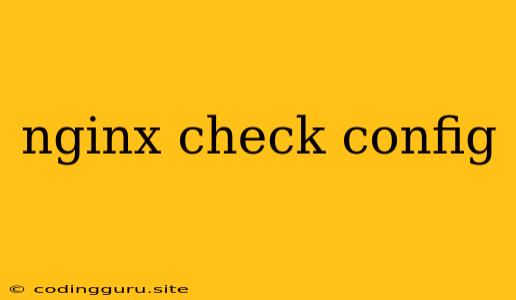Nginx Check Config: Ensuring a Smooth Operation
Nginx, a powerful and popular web server, plays a vital role in serving your websites and applications. It handles requests, routes traffic, and delivers content efficiently. However, a misconfigured Nginx configuration file can lead to various issues, ranging from slow performance to complete server downtime. Therefore, it's crucial to check your Nginx configuration regularly for any errors or potential problems.
Why is Nginx Configuration Check Essential?
- Preventing Errors: A properly configured Nginx setup ensures seamless operation, preventing errors and unexpected behavior.
- Optimizing Performance: A well-structured configuration optimizes performance, enabling faster loading times and efficient resource utilization.
- Security Enhancement: Nginx configuration plays a vital role in security. A properly configured setup protects your server against potential vulnerabilities.
- Troubleshooting Issues: When encountering issues, checking the Nginx configuration often helps identify the root cause and facilitates problem resolution.
How to Check Your Nginx Configuration?
There are two primary methods for checking your Nginx configuration:
1. Using the nginx -t Command:
This command is the most common and straightforward way to check your Nginx configuration. It performs a syntax check and ensures that the configuration file is valid.
Here's how to use it:
- Open your terminal or command prompt.
- Navigate to the directory where your Nginx configuration file is located.
- Execute the following command:
sudo nginx -t
Output Interpretation:
- Success: If the configuration is valid, you'll see a message like "nginx: the configuration file /etc/nginx/nginx.conf syntax is ok" and "nginx: test configuration successful".
- Errors: If any syntax errors are found, the command will display the error message and the line number where the error occurred.
2. Using the nginx -T Command:
While nginx -t checks for syntax errors, nginx -T provides a more detailed output, showing the parsed configuration file in a human-readable format.
Here's how to use it:
- Open your terminal or command prompt.
- Navigate to the directory where your Nginx configuration file is located.
- Execute the following command:
sudo nginx -T
Output Interpretation:
The output displays the configuration file in a structured format, highlighting the various directives, blocks, and their values. This can be helpful for debugging complex configurations or identifying potential inconsistencies.
Common Nginx Configuration Errors and Solutions
Here are some common errors encountered while checking Nginx configuration:
- Syntax Errors:
- Missing Semicolon: Each line in the Nginx configuration file should end with a semicolon (
;). - Incorrect Directive: Ensure that the directives and their arguments are used correctly, following the official Nginx documentation.
- Mismatched Braces: Verify that opening and closing curly braces (
{}) are properly matched and used in the correct locations.
- Missing Semicolon: Each line in the Nginx configuration file should end with a semicolon (
- Conflicting Directives:
- Duplicate Directives: Avoid defining the same directive multiple times within the same block or scope.
- Conflicting Values: Check for conflicts in directive values, especially when using multiple
serverblocks or locations.
- Access and Permissions:
- File Permissions: Ensure that the Nginx configuration file and its related files have the appropriate read and write permissions for the Nginx process.
- Directory Permissions: Verify that the directories containing configuration files and log files are accessible by Nginx.
Troubleshooting Tips:
- Review Nginx Logs: Check the Nginx error log file (
/var/log/nginx/error.log) for detailed error messages. These messages can provide valuable clues about the cause of the configuration issues. - Compare Configurations: If you are making changes to your Nginx configuration, it's beneficial to compare the new configuration with a known working version to identify any potential issues.
- Consult Documentation: Refer to the official Nginx documentation for detailed information about directives, syntax, and best practices.
- Use Online Configuration Checkers: Several online tools are available that can help check your Nginx configuration for syntax errors and provide suggestions for improvement.
Best Practices for Nginx Configuration:
- Use clear and descriptive names for directives and variables.
- Comment your configuration file adequately.
- Break down complex configurations into smaller, manageable files.
- Use inheritance to reduce code duplication.
- Test your configuration changes thoroughly before deploying them to a live server.
Conclusion
Checking your Nginx configuration is a crucial step in maintaining a stable and efficient web server. Regular checks and proper configuration management are essential for preventing errors, optimizing performance, and enhancing security. By following the tips and best practices outlined above, you can ensure that your Nginx server runs smoothly and delivers a positive user experience.
